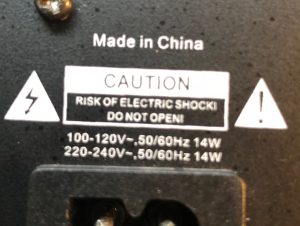First of all, let me say “hi there, Googlers!”
I owned the M-Audio StudioPro 3 speakers for quite a few years before they started to fail on me. Â They were not too bad, gave decent sound at reasonable desktop volume. Â In the last year or so, the right speaker conked out. Â Well, it played, but was really really quiet. Â I replaced the cable a few times, and tested with an oscilloscope that yes, it was actually receiving signal, but very weak.
I opened it up and couldn’t see any immediate issues, like loose connections or popped capacitors. Â I tried making a better solder joint on the wire leading to the right speaker jack, but didn’t notice an improvement.

Much of my research leads to the understanding that these units will eventually fail, even if I fixed it now. Â I decided I might as well convert the speaker into a passive speaker, and bypass the amp entirely. Â I first thought this was as easy as attaching the speaker terminals, then I realized I still need the crossover, of course. Â I just needed to find it on the board.
With the help of this page (thank you Yashar), I found at the very bottom of the page a rough estimation of what the crossover will look like in this speaker.  It is slightly different from the AV40, but the general layout of the two inductors helped me locate the general area I was looking for.

Armed with that and a little function generator I was able to find the spot after the power amp and before the crossover. Â Here it is, with the original output wire removed from its spot and soldered on to an existing joint.
I removed it shortly after and threaded the wire through the hole alongside the zip tie for a small amount of strain relief. Â Now the 1/8″ jack, instead of sending amplified signal OUT to the right speaker, is an input for amplified signal. Â In other words, it is now a passive speaker, just like the right side one.
I can leave it unplugged from AC and still use it, as long as I have a small amp, like the little LEPY amps on Amazon/AliExpress. Â The speakers seem to be rated 10W and 4ohms so I certainly can’t drive them hard with that little amp, but I think I can easily get a lot more life out of them, especially with the right one being significantly less dead than before.
I can’t guarantee that I did this right, and maybe someone will correct me, but I think I found a simple solution to save these.

Leave a Reply to Zacky Cancel reply
You must be logged in to post a comment.